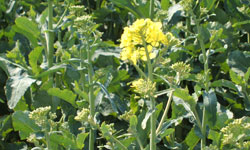
As oilseed rape moves into the flowering phase, growers will be moving their attention to the late diseases, Sclerotinia, Alternaria and Botrytis. The risk from these diseases should be assessed now and plans made to apply a protectant fungicide, such as Filan, before the disease-infected petals fall and stick onto the stems and branch axils and when the weather is suitable, warns BASF.
"Choice of fungicide treatments at this time is usually made on the basis of a number of critical factors. First and foremost it should be the level of disease control expected as well as the disease spectrum offered. Cost-effectiveness is also important and so yield and quality responses should be part of the decision making process. Extra physiological effects can add to the yield response, too. Then practicalities such as the ability to mix with pyrethroids and resistance management should be factored in," says Diane Heath, BASF Oilseed Rape Product Manager.
"Filan (boscalid) has performed exceptionally well in commercial use and in trials across many different years and under different disease pressures. It is the standard fungicide against which others are measured. In a series of eight trials, Filan gave an average 93% control of Sclerotinia. In another set of trials it gave an average of 87% control of Sclerotinia compared with 66% control from azoxystrobin. Filan can be relied upon to give the best protection against Sclerotinia, as well as broad-spectrum activity on Alternaria, Botrytis, Phoma and late Light Leaf Spot. Against Alternaria, Filan gave 70% control compared with 48% for azoxystrobin in trials," says Diane.
Diane explains that effective disease control at this critical period in the crop’s development should not be compromised as it will be reflected in the final yields achieved. "Sclerotinia in oilseed rape causes premature senescence, reduced seed weight, early seed loss from pods and significant yield loss. So effective control will result in good yield responses and will pay over and above the cost of treatment and application. In trials a Filan treatment at flowering resulted in a yield of 4.93 t/ha, compared with 4.75 t/ha given by azoxystrobin and 4.27 t/ha in the untreated. This extra 0.66 t/ha is valued at £109 with rape at £165/tonne. In UAP 2006 trials, a programme of Caramba (metconazole) and Filan gave an extra yield of 2.3 t/ha."
Boscalid has also been scientifically proven to add yield through its physiological effects. It increases chlorophyll and nitrogen in the pods, improving photosynthesis. It reduces ethylene in the plant which reduces stress and prolongs seed fill period and it has been shown to induce host defence in the plant. These bonus effects add to extra yield even in the absence of disease.
"Filan also has excellent compatibility and is bee safe when tank mixed with a pyrethroid at flowering for seed weevil and pod midge. Triazole chemistry has been demonstrated not to be safe in this context as it adversely affects the repellency of the insecticide to bees. Not being a triazole is also a benefit to Filan as its use introduces a different fungicide group with a different mode of action into the crop. If you have used triazoles earlier in the programme for Phoma or Light Leaf Spot or growth regulation, it makes more sense to move to another fungicide group such as the carboxamides as a longer-term anti-resistance measure. It may also help to ensure that the maximum dose of any one chemical is not exceeded," points out Mrs. Heath.
"This year when crops are early, the persistence of Filan will be invaluable allowing more flexible timing from late yellow bud to early flowering onwards without compromising on disease control. In trials a pre-flowering application of Filan resulted in 60% control of Sclerotinia whereas prothioconazole gave just 19%. When these fungicides were applied later at a more appropriate time, at full flower, Filan gave 84% control and prothioconazole gave 77%. When field situations or timing are not perfect, it makes sense to use a more reliable, flexible treatment," concludes Diane.
ADAS and BASF are continuing to provide a weekly Sclerotinia monitoring report on the www.totaloilseedcare.co.uk web site. Growers and advisors should log onto this site in order to track sclerotia germination in their region, including Scotland, to assess disease risk and then decide on the need for fungicide treatment. This year germination started earlier than normal. Seasonal risk of Sclerotinia will be influenced by the germination pattern relative to flowering and the weather conditions at petal fall.
Background Notes - Filan contains 50% w/w boscalid, formulated as a water dispersible granule, packed in a 2.5 kg pack. It is recommended in oilseed rape for the control of Sclerotinia stem rot and Alternaria. It is a protectant and systemic fungicide. It is recommended in high disease risk situations at early to full flowering (BBCH Growth Stage 63-65) at a dose rate of 0.5 kg/ha. It has no LERAP.
